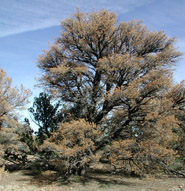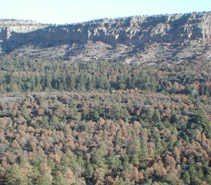|
|
 |
Piñon Pine Mortality
Rapid, regional-scale mortality of piñon pine (Pinus edulis)—one of the most extensive vegetation types in western North America—resulted from drought accompanied by anomalously high temperatures that occurred in the Southwest between 2000 and 2003. Although most of the piñon pine mortality occurred in response to bark beetle (Ips confusus) outbreaks, climatic water stress can greatly affect trees’ susceptibility to attack by bark beetles. Unlike a similar drought in the 1950s, which resulted in patchy tree mortality and affected trees more than 100 years old, the most recent drought was wetter but warmer and resulted in nearly complete tree mortality across many size and age classes, including as much as 90% mortality for trees at high elevations. Higher temperatures exacerbate the metabolic stress on piñon pine, indicating droughts of shorter duration would be sufficient to cause wide spread die-off under warmer temperatures in the future. |
Ponderosa Pine Mortality
Like piñon pine, the Southwest’s ponderosa pine (Pinus ponderosa) forests experienced extensive and accelerating tree mortality from 1997 to 2007 in response to drought and increased bark beetle populations. The proximate cause of mortality was bark beetle (primarily Ips spp.) outbreaks, however, these outbreaks likely were mediated by long-term drought conditions. The dry and hot conditions are thought to have stressed the trees and made them more susceptible to bark beetles and other pathogens. This argument is bolstered by findings that show mortality rates accelerated after 2002, the driest year in the past 100 years. |
 |
Research
-
Adams, H. D., M. Guardiola-Claramonte, G. A. Barron-Gafford, J. Camilo Villegas, D. D. Breshears, C. B. Zou, P. A. Troch, and T. E. Huxman. 2009. Temperature sensitivity of drought-induced tree mortality portends increased regional die-off under global-change-type drought. Proceedings of the National Academy of Science 106: 7063–7066.
-
Bentz, B. J., J. Regniere, C. J. Fettig, E. M. Hansen, J. L. Hayes, J. A. Hicke, R. G. Kelsey, J. F. Negron, and S. J. Seybold. Climate change and bark beetles of the western United States and Canada: Direct and indirect effects. BioScience 60: 602–613.
- Breshears, D. D., N. S. Cobb, P. M. Rich, K. M. Price, C. D. Allen, R. G. Balice, W. Romme H., J. H. Kastens, L. M. Floyd, J. Belnap, J. J. Anderson, O. B. Myers, and C. Meyer W. 2005. Regional Vegetation die-off in response to global-change-type drought. Proceedings of the National Academy of Sciences 102:15144–15148.
- van Mantgem, P. J., N, L. Stephenson, J. C. Byrne, L. D. Daniels, J. F. Franklin, P. Z. Fulé, M. E. Harmon, A. J. Larson, J. M. Smith, A. H. Taylor, and T. T. Veblen. 2009. Widespread increase of tree mortality rates in the western United States. Science 323:521–524.
|
|

